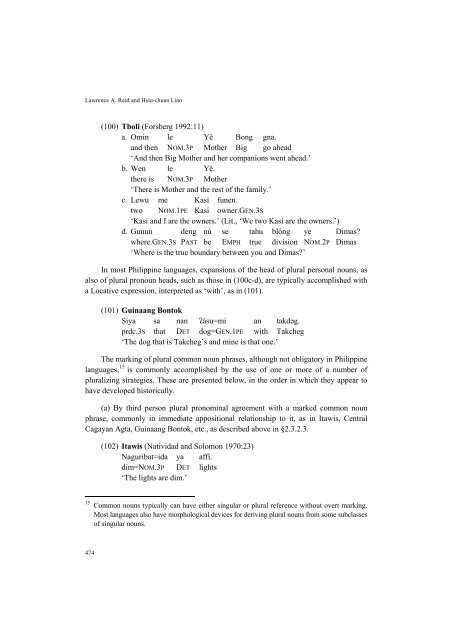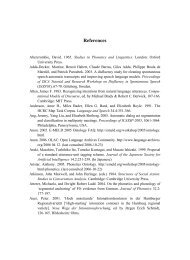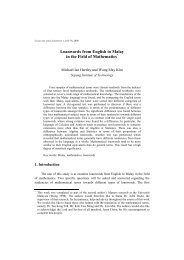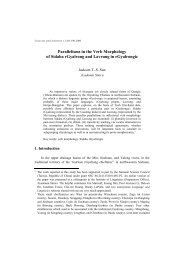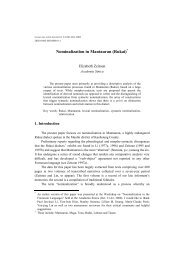A Brief Syntactic Typology of Philippine Languages - Academia Sinica
A Brief Syntactic Typology of Philippine Languages - Academia Sinica
A Brief Syntactic Typology of Philippine Languages - Academia Sinica
You also want an ePaper? Increase the reach of your titles
YUMPU automatically turns print PDFs into web optimized ePapers that Google loves.
Lawrence A. Reid and Hsiu-chuan Liao<br />
474<br />
(100) Tboli (Forsberg 1992:11)<br />
a. Omin le Yê Bong gna.<br />
and then NOM.3P Mother Big go ahead<br />
‘And then Big Mother and her companions went ahead.’<br />
b. Wen le Yê.<br />
there is NOM.3P Mother<br />
‘There is Mother and the rest <strong>of</strong> the family.’<br />
c. Lewu me Kasi funen.<br />
two NOM.1PE Kasi owner.GEN.3S<br />
‘Kasi and I are the owners.’ (Lit., ‘We two Kasi are the owners.’)<br />
d. Gunun deng nù se tahu blóng ye Dimas?<br />
where.GEN.3S P AST be EMPH true division NOM.2P Dimas<br />
‘Where is the true boundary between you and Dimas?’<br />
In most <strong>Philippine</strong> languages, expansions <strong>of</strong> the head <strong>of</strong> plural personal nouns, as<br />
also <strong>of</strong> plural pronoun heads, such as those in (100c-d), are typically accomplished with<br />
a Locative expression, interpreted as ‘with’, as in (101).<br />
(101) Guinaang Bontok<br />
Siya sa nan /ásu=mi an takdəg.<br />
prdc.3S that DET dog=GEN.1PE with Takcheg<br />
‘The dog that is Takcheg’s and mine is that one.’<br />
The marking <strong>of</strong> plural common noun phrases, although not obligatory in <strong>Philippine</strong><br />
languages, 15 is commonly accomplished by the use <strong>of</strong> one or more <strong>of</strong> a number <strong>of</strong><br />
pluralizing strategies. These are presented below, in the order in which they appear to<br />
have developed historically.<br />
(a) By third person plural pronominal agreement with a marked common noun<br />
phrase, commonly in immediate appositional relationship to it, as in Itawis, Central<br />
Cagayan Agta, Guinaang Bontok, etc., as described above in §2.3.2.3.<br />
(102) Itawis (Natividad and Solomon 1970:23)<br />
Naguribat=ida ya affi.<br />
dim=NOM.3P DET lights<br />
‘The lights are dim.’<br />
15 Common nouns typically can have either singular or plural reference without overt marking.<br />
Most languages also have morphological devices for deriving plural nouns from some subclasses<br />
<strong>of</strong> singular nouns.


